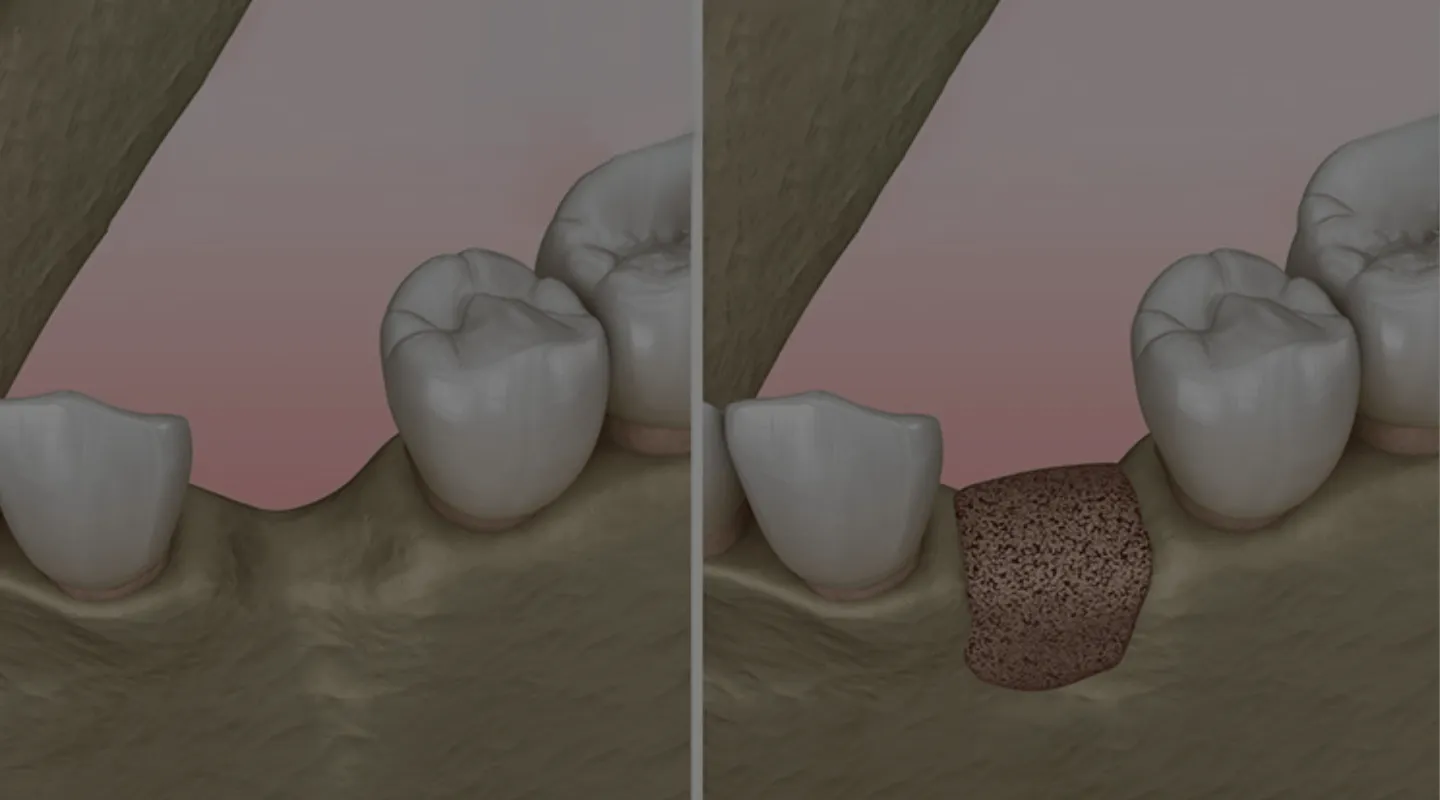
Bone Graft
Your Bone Graft in Tunisia at an Affordable Price
Reconstruct your jawbone to safely place your implants. Bone grafting at TDS is performed by our surgeons specializing in implantology.
How does it work?
Bone graft for dental implant
To guarantee the success of dental implant treatment, it is essential that the jawbone has sufficient bone structure to support the implant or implants. However, if the bone under the gum is not wide, high, or thick enough, a bone graft may be necessary to strengthen the bone base for implant fixation. When considering dental implantation, it is essential to understand what a bone graft is, the procedure, and the possible after-effects.
Bone graft: what is it?
Bone grafting involves restoring or replacing jawbone using bone or bone-like materials to support dental implants. Grafts can be more or less complex, ranging from a simple bone elevation around the implant to a significant modification of the shape and size of the dental arch.
How much does a bone graft cost in Tunisia?
The cost of a bone graft can vary depending on several factors such as the size and shape of the area to be repaired, the method used, and where the bone is taken from.
Where does jawbone loss come from?
Bone loss can occur following a shock or injury, an infection such as an abscess, and periodontal disease. In addition, the bone structure under missing teeth tends to lose density over time. Patients who have been missing teeth for months or years often need bone grafts before they can get implants.
Who performs bone grafting for dental implants?
Minor grafts can be performed by a dentist, while more complex bone grafts involving bone harvesting are performed by a maxillofacial surgeon.
What are the main sources for performing a bone graft?
Here are the main sources of materials used to perform a bone graft.
Your own bone
The best option in terms of safety and effectiveness is to use this source, which integrates perfectly without any risk of disease, contamination, or tissue rejection. Sometimes, the bone from the chin or jaw is used, but it is also possible to harvest bone from a tibia or hip. This solution requires two surgical sites. It is expensive because it often requires hospitalization.
Animal bone-based bone powder
Cow bone has been commonly used for many years. It is sterilized and treated to minimize infection. This graft material is naturally absorbed by the body and replaced by real bone over time. The bone graft is performed in the office and takes barely 30 minutes. This choice is indicated for slight bone loss.
Synthetic mineral powder
Although less effective than other options, this sterile bone-like material is absorbed and replaced over time. The procedure is also performed in the office by the dentist and lasts 30 minutes.
How does the dentist choose the type of bone graft?
In order to determine the technique and choice of bone graft, the dentist will study the various panoramic X-rays and 3D cone beam radiographic sections. To strengthen bone density, the dentist may use a powdered bone graft if slight improvement is necessary. In the case of more significant bone loss, the choice will rather be for a bone graft with harvesting of the patient’s bone.
How to maximize the success of a bone graft through adequate preparation and precautions?
It is crucial to prepare well and take all necessary precautions before performing a bone graft to ensure the success of the procedure and the patient’s recovery. Before the procedure, it is essential to conduct a thorough assessment of the patient’s general health, including radiological examinations to determine the quality and quantity of bone required. To provide optimal care, patients can be informed of the preparatory measures to take before the procedure, such as stopping certain medications and lifestyle habits, in order to reduce risks. During transplantation, particular attention is paid to cleanliness to minimize the risk of infections. After the operation, it is common to follow periods of rest and to comply with strict instructions in order to avoid any excessive pressure on the grafted area. It is crucial to ensure regular follow-up after a graft to detect any possible complications. By being rigorous in following these preparation and precaution steps, patients increase their chances of success and promote ideal recovery after a bone graft.
How does the bone graft process using the patient's bone proceed?
Donor area: the chin
The maxillofacial surgeon administers local anesthesia to the donor and recipient area. An incision is made in the gum at the recipient site, followed by an incision under the lower anterior teeth, exposing the chin bone. A block of bone and bone marrow is removed from the chin. The surgeon will then carefully cover the area with tissue or a bone substitute. This will prevent the gums from infiltrating the hole during healing. After closing the incision on the donor area, the bone graft will be delicately installed on the area to be treated and secured in place with small titanium screws. The latter will be removed after the healing period for optimal results. A mixture of marrow and other materials is placed on the edges of the grafted bone to stimulate bonding. The surgeon then places a tissue membrane over the graft before closing the incision.
Donor area: the Hip
If the bone is taken from the chin, the surgeon can harvest the bone in the office while administering sedation. On the other hand, if it is harvested from the hip, a 2-day hospitalization is necessary. The harvested bone will be placed in the recipient area in the same way described above. It takes at least 6 months for the grafted bone to heal and bond with the jaw. Only after this period can dental implants be considered.
Our advantages


How do the post-operative procedures and preparation for a bone graft proceed?
After undergoing a bone graft from a bone harvest, the patient will be prescribed analgesic medication, antibiotics, and an antibacterial mouthwash. It is recommended that the patient avoid certain foods and not put excessive pressure on the jaws. Mouth guards may be indicated in this regard. It is important to take into account the size of the graft and your choice. In general, it takes at least 6 months, or even more, before the jaw is strong enough to receive implants. During this period, it is essential to continue rigorous oral care such as regular brushing, etc., to maintain good dental health.
What is guided bone regeneration?
Guided bone regeneration, an innovative approach in dental and orthopedic surgery, aims to stimulate bone growth in specific areas. This technique relies on the use of biocompatible membranes that create a physical barrier, thus promoting the development of new bone tissue. Before starting the procedure, it is essential to conduct a thorough assessment of bone health to determine if regeneration is necessary and the type of membrane to use. During the procedure, the membrane plays a crucial role in guiding cell growth and protecting the regeneration area from surrounding soft tissues. This approach is frequently used in dental bone grafts, orthopedic surgeries, and fracture treatments. Thanks to guided bone regeneration, the benefits are numerous: faster recovery and lasting results. It is a major advance in the restoration of bone structures, providing effective solutions to overcome the difficulties caused by bone loss or lesions.
What is the length of stay in Tunisia for a bone graft?
A stay of 1 to 3 days is required to perform the bone graft depending on the technique indicated. The patient can take advantage of this stay to have dental implants placed when the bone part is thick, dental crowns, dental veneers or teeth whitening.
Your Bone Graft in Tunisia with TDS
Would you like to receive a quote for your bone graft in Tunisia? The TDS team is here to help you in every way possible. Simply fill out our online form and we will be happy to answer all your questions about bone grafting and provide you with all the necessary information for organizing your stay in Tunisia.
Your health, our priority.
Request your free quote.
Frequently Asked Questions
A bone graft is often necessary before a dental implant to compensate for bone loss in the jaw. This creates a solid and stable base for the implant, ensuring its integration and durability.
Sources of bone grafts include autografts (from the patient themselves), allografts (from a human donor), xenografts (from animals), and synthetic grafts (manufactured materials).
Recovery after a bone graft varies depending on the extent of the procedure. Generally, patients may experience pain and swelling for a few days, but complete healing can take several months. Pain medication and antibiotics may be prescribed to prevent infection.
Risks include infection, graft rejection, bleeding, nerve damage, and bone resorption. However, these complications are rare and can be managed effectively with appropriate care.
Yes, a bone graft can fail if the graft does not integrate properly with the existing bone, due to factors such as infection, smoking, or underlying medical conditions. In these cases, additional intervention may be necessary.
When successful, a bone graft can last a lifetime. However, continued oral health and the absence of risk factors such as smoking are essential to maintain the viability of the graft.
No, not all patients are candidates for a bone graft. People with severe medical conditions, coagulation disorders, or those who smoke heavily may not be good candidates.
Recent innovations include the use of growth factor technology, bioactive synthetic grafts, and guided tissue regeneration (GTR) techniques that improve success and reduce recovery time.
A successful bone graft allows for more precise and flexible planning of dental implants. It ensures an adequate bone base, allowing for better positioning and optimal alignment of the implants.
Pre-operative evaluation is crucial to determine the necessity and feasibility of the bone graft. It includes clinical examination, radiographic imaging, and sometimes blood tests to assess the patient’s general health and bone structure.
